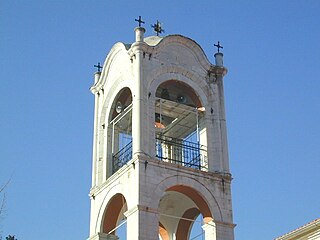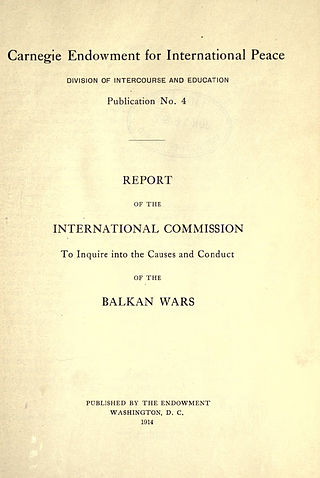
The Balkan Wars were a series of two conflicts that took place in the Balkan states in 1912 and 1913. In the First Balkan War, the four Balkan states of Greece, Serbia, Montenegro and Bulgaria declared war upon the Ottoman Empire and defeated it, in the process stripping the Ottomans of their European provinces, leaving only Eastern Thrace under the Ottoman Empire's control. In the Second Balkan War, Bulgaria fought against the other four original combatants of the first war. It also faced an attack from Romania from the north. The Ottoman Empire lost the bulk of its territory in Europe. Although not involved as a combatant, Austria-Hungary became relatively weaker as a much enlarged Serbia pushed for union of the South Slavic peoples. The war set the stage for the July crisis of 1914 and thus served as a prelude to the First World War.

The First Balkan War lasted from October 1912 to May 1913 and involved actions of the Balkan League against the Ottoman Empire. The Balkan states' combined armies overcame the initially numerically inferior and strategically disadvantaged Ottoman armies, achieving rapid success.

The Second Balkan War was a conflict that broke out when Bulgaria, dissatisfied with its share of the spoils of the First Balkan War, attacked its former allies, Serbia and Greece, on 16 (O.S.) / 29 (N.S.) June 1913. Serbian and Greek armies repulsed the Bulgarian offensive and counterattacked, entering Bulgaria. With Bulgaria's also having previously engaged in territorial disputes with Romania and the bulk of Bulgarian forces engaged in the south, the prospect of an easy victory incited Romanian intervention against Bulgaria. The Ottoman Empire also took advantage of the situation to regain some lost territories from the previous war. When Romanian troops approached the capital Sofia, Bulgaria asked for an armistice, resulting in the Treaty of Bucharest, in which Bulgaria had to cede portions of its First Balkan War gains to Serbia, Greece and Romania. In the Treaty of Constantinople, it lost Adrianople to the Ottomans.

Henry Noel Brailsford was a British journalist and writer, considered one of the most prolific left-wing journalists of the first half of the 20th century. A founding member of the Men's League for Women's Suffrage in 1907, he resigned from his job at The Daily News in 1909 when it supported the force-feeding of suffragettes on hunger strike.

Doxato is a town and municipality in the Drama regional unit, in East Macedonia and Thrace, Greece. The seat of the municipality is the town Kalampaki.

The London Conference of 1912–1913, also known as the London Peace Conference or the Conference of the Ambassadors, was an international summit of the six Great Powers of that time convened in December 1912 due to the successes of the Balkan League armies against the Ottoman Empire in the First Balkan War. In particular, the conference intended to arbitrate between the warring powers as to territorial acquisitions, and also to determine the future of Albania, whose independence was proclaimed during the conflict.

The Ser-Drama-Lagadin-Nevrokop dialect is a dialect currently treated both in the contexts of the southeastern group of Bulgarian dialects and the southeastern subgroup of dialects of the Macedonian. Prior to the codification of standard Macedonian in 1945, the dialects of Macedonia were classified as Bulgarian. The dialect is dynamic and is well known for the shortening of the words, and also characterised by the excessive use of for the Proto-Slavic yat even in cases where standard Bulgarian has, a feature which is typical for a number of dialects spoken in southern and southwestern Bulgaria . The Ser-Drama-Lagadin-Nevrokop dialect is closely related to the neighbouring dialects. It is closer to all Eastern Bulgarian dialects than to all Western. Macedonian shares much less features with the dialect than it does with the Maleševo-Pirin dialect of Macedonian and Bulgarian. Some Bulgarian dialects are more similar to Macedonian than the Ser-Nevrokop dialect, the Samokov dialect shares more features with Macedonian than both the Ser-Nevrokop and the Pirin-Malasevo dialects do, even though it is not considered a Macedonian dialect, the most of the western Bulgarian dialects and the Smolyan dialect share more similarities with Macedonian than the Ser dialect does. The Samokov dialect, most remarkably, shares with Macedonian and the Maleševo-Pirin dialect—the "to be" verb for future tense—"ke", which in contrast is "shte" in the Ser-Nevrokop dialect and in the Bulgarian language. The Yat border passes through the Maleševo-Pirin dialect and divides it on such a way that in the northern area of the dialect the yat is pronounced "e" and in the south—"ya". In the Ser-Nevrokop dialect the yat is pronounced in most places "ya", therefore the city of Serres, after which the dialect is named, is called "Syar" by the locals, as opposed to "Ser" in Macedonian. The first person singular is as in Bulgarian, ending with "a" or "am" as opposed to the constant "am" in Macedonian and the Bulgarian Smolyan dialect. The words for man -"m'zh" and for a dream "s'n" are as in Bulgarian, unlike the Macedonian "mazh" and "son". The words for night and tear—"nosht" and "s'lza" are as the Bulgarian, unlike the Macedonian "nok" and "solza".

The Albanian Declaration of Independence was the declaration of independence of Albania from the Ottoman Empire. Independent Albania was proclaimed in Vlorë on 28 November 1912. Six days later the Assembly of Vlorë formed the first Government of Albania which was led by Ismail Qemali and the Council of Elders (Pleqnia).
The Ohrid–Debar uprising was an uprising by the population in Western Macedonia, then Kingdom of Serbia, in September 1913. It was organized by the Internal Macedonian Revolutionary Organization (IMRO) and Albania against the Serbian capture of the regions of Ohrid, Debar and Struga after the Balkan Wars (1912–13).

Independent Albania was proclaimed on 28 November 1912. This chapter of Albanian history was shrouded in controversy and conflict as the larger part of the self-proclaimed region had found itself controlled by the Balkan League states: Serbia, Montenegro and Greece from the time of the declaration until the period of recognition when Albania relinquished many of the lands originally included in the declared state. Since the proclamation of the state in November 1912, the Provisional Government of Albania asserted its control over a small part of central Albania including the important cities of Vlorë and Berat.

The massacres of Albanians in the Balkan Wars were perpetrated on several occasions by the Serbian and Montenegrin armies and paramilitaries during the conflicts that occurred in the region between 1912 and 1913. During the 1912–13 First Balkan War, Serbia and Montenegro committed a number of war crimes against the Albanian population after expelling Ottoman Empire forces from present-day Albania, Kosovo, and North Macedonia, which were reported by the European, American and Serbian opposition press. Most of the crimes occurred between October 1912 and the summer of 1913. The goal of the forced expulsions and massacres was statistical manipulation before the London Ambassadors Conference to determine the new Balkan borders. According to contemporary accounts, around 20,000 to 25,000 Albanians were killed in the Kosovo Vilayet during the first two to four months, before the violence climaxed. The total number of Albanians that were killed in Kosovo and Macedonia or in all Serbian occupied regions during the Balkan Wars is estimated to be at least 120,000. Most of the victims were children, women and the elderly. In addition to the massacres, some civilians had their lips and noses severed. Multiple historians, scholars, and contemporary accounts refer to or characterize the massacres as a genocide of Albanians or the Muslim population in the Balkans as a whole. Further massacres against Albanians occurred during the First World War and continued during the interwar period.

The Report of the International Commission to Inquire into the Causes and Conduct of the Balkan Wars is a document published in Washington D.C. in 1914 by the Carnegie Endowment for International Peace.

The Kingdom of Serbia was one of the major parties in the Balkan Wars, gaining land in both conflicts. It experienced significant territorial gains in the Central Balkans, nearly doubling its territory.

The Albanian Vilayet was a projected vilayet of the Ottoman Empire in the western Balkan Peninsula, which was to include the four Ottoman vilayets with substantial ethnic Albanian populations: Kosovo Vilayet, Scutari Vilayet, Manastir Vilayet, and Janina Vilayet. In some proposals, it included the Salonica Vilayet as well. The creation of the Vilayet was confirmed in September 1912, but negotiations were interrupted a month later in October by the beginning of the First Balkan War. Plans for an Albanian Vilayet were lost with the Partition of Albania.

The All-Albanian Congress, Albanian National Congress, or Albanian Independence Congress was a held in Vlorë on November 28, 1912. Congress participants constituted the Assembly of Vlorë which established Albanian Provisional Government and elected Ismail Qemali as its president.

Independent Albania was a parliamentary state declared in Vlorë on 28 November 1912 during the First Balkan War. Its assembly was constituted on the same day while its government and senate were established on 5 December 1912.
The Battle of Lumë, also referred by the Albanians as the Uprising of Lumë, was a series of clashes between the Albanian locals of the region of Lumë in Ottoman Albania against the invading Serbian army in 1912 during the First Balkan War period. As the Kingdom of Serbia sought to gain access to the Adriatic Sea, the Serbian army met significant resistance from Albanian militia in the Luma region, resulting in the defeat of the Serbian forces. In securing the central Adriatic coast in Albania, Albanian political figureheads were able to disembark in Durrës and proceed with their plans for the eventual Albanian Declaration of Independence.

Albania's Golgotha: Indictment of the Exterminators of the Albanian People, is a German published document of 1913 which was written by the Austrian publicist and politician Leo Freundlich (1875-1953). The document is a compilation of news which he gathered when traveling in the Vilayet of Kosovo during the Serbian invasion of 1912-1913, explaining in detail the full-scale massacres, rape, expulsions, torture and abuse which Albanian civilians suffered under rule by the Serb army and Chetnik paramilitaries. According to the documents of Freundlich, 25,000 Albanians were massacred in the Kosovo Vilayet halfway through the First Balkan War. The document describes the methods of ethnic cleansing which was used to remove the Albanian population of North Macedonia, Northern Albania, and Kosovo. The document was re-translated by Robert Elsie. The reports were confirmed by the International Commission to Inquire into the Causes and Conduct of the Balkan War.
















